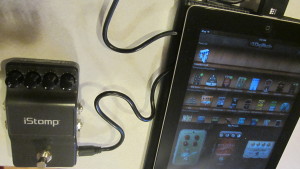
Pumping Up the Organ Tones with the iStomp
Digitech RPs have a very nice single-line pitch shifter, and a very nice rotary speaker effect too. If you could use them both at once, which you can’t do on a single RP, you’d get some decent simple organ tones. (You can actually get decent organ tones with a rotary speaker alone, but a pitch shifter helps a lot.) But if you really want to emulate the sound of a Hammond organ, you need multi-timbral pitch shifting–the kind you get with an ElectroHarmonix POG or HOG, where you have multiple independent pitch-shifted lines running in parallel. Unfortunately, a HOG or POG costs $300 and up, and it takes up a pretty big chunk of space at your feet, too.
I decided last week to check out a promising alternative: the Digitech iStomp, an interesting device that’s essentially a reconfigurable stompbox. I bought my iStomp from guitarcenter.com used for about $60 shipped, a savings of close to 50% compared to buying new.

Using an iOS device like an iPad or an iPhone equipped with Digitech’s free “Stomp Shop” app, you load the iStomp with the effect of your choice (one at a time–this is not a Digitech RP). Among the effects Digitech provides for this device (for free!) is one called the “swing shift.” This multitimbral pitch shifter will simultaneously shift any incoming pitch an octave down, one and two octaves up, and a 5th up. The proportions of each in the sound can be precisely controlled in real time via a row of 4 rotary dials. This works very well for emulating an organ, since you can add or subtract shifted pitches to the tone easily and precisely. The pitch shifting, as per Digitech’s generally excellent implementation of anything having to do with pitch, is clean and tracks up and down the harp with no discernible lag.
I positioned the thing in a short FX chain with the iStomp at the start of the chain and a Digitech RP500 at the end, the latter running a patch with a rotary speaker effect (and an amp model, of course) from my patch set for Digitech RP500. This setup produces perfectly usable organ tones, with a much higher degree of realism than you can produce with only a rotary speaker effect. The ability to modulate the mix of added pitches in real time does a lot to advance the illusion. Add in the ability to control “rotating speaker” speed with the RP’s expression pedal, and you’ve got the big expressive organ moves covered.
This is a recording I made straight into the Zoom H4’s 1/4″ input from the mono 1/4″ output on my RP360XP, with the 360XP following the iStomp running Swingshift. No post-processing was done on the recording except to normalize the volume. The RP360XP is running the CHAMPDRO (Champ amp model, Deluxe 1×12 cab model, rotary speaker effect) patch from my patch set for RP360XP. First I play a few slow chords with just the RP360XP patch, working the expression pedal to speed up the rotary speaker; it’s a nice sound, and reasonably organ-like. But you can really hear the difference when the iStomp kicks in, and you can hear the various pitch-shifted lines fade in and out as I work the dials, along with the expression pedal on the 360XP, this time going fast to slow. Lotta stuff happening there.
Swing Shift with RP360XP organ sounds
Assuming that the RP on the back end is an RP255 at least–the minimum RP device if you want an expression pedal to modulate the rotary speaker speed up and down–the cost for this setup (buying everything used, which I recommend, because Digitech generally builds its products to withstand anything short of a direct asteroid strike, so the used stuff works pretty much like the new stuff) is about $125-$150. If you already have an RP255 or some other rotary speaker effect, the price is about $50 for the (used) iStomp alone. You could cut the price for both FX to around $100-$125 total if you replace the RP in the chain with another used iStomp. You can use the second iStomp to run the rotary speaker effect (which Digitech provides for free as a download from their site–in fact, almost everything they offer for the iStomp is free). Of course you’d miss out then on all the other cool stuff you could do with an RP in the chain, but you’d nail the organ tones. In effect, the iStomp running Swing Shift is a POG at one-sixth the price, which leaves plenty of dough for the rotary speaker effect.
This all assumes that you already have an iPhone, iPad, or other iOS device. If you don’t, then you have to figure the cost of one of those into the setup, or talk one of your friends into letting you use theirs. But if you have one of those devices, this appears to me to be the lowest-cost approach to achieving a quality organ sound with harmonica, or guitar, or anything besides an organ.
Tags In
Related Posts
4 Comments
Leave a Reply
You must be logged in to post a comment.
WHAT’S NEW
Categories
- Audio/Video
- Blog
- Blue Future
- Digitech RP Tricks and Tips
- Discography, CDs, Projects, Info, Notes
- Featured Video
- For the Beginner
- Gallery
- Hunter's Effects
- Hunter's Music
- Huntersounds for Fender Mustang
- Meet the Pros
- More Video
- MPH: Maw/Preston/Hunter
- My Three Big Contributions
- Player's Resources
- Pro Tips & Techniques
- Recommended Artists & Recordings
- Recommended Gear
- Recorded Performances
- Reviews, Interviews, Testimonials
- The Lucky One
- Uncategorized
- Upcoming Performances
- Zoom G3 Tips and Tricks


Hey Richard – Your are to be highly praised for your generosity in sharing the results of your experiments with harmonica tone modification! Thank you! And what a cool sound with “Pumping Up The Organ Tones With The Istomp.” Thank you, thank you, thank you!
@Seth You’re welcome! How’s things in PA?
HI Richard, was your sample done with a single harp tone or chords?
@Robert: chords, first 3-4 holes on a C harp (as I recall).